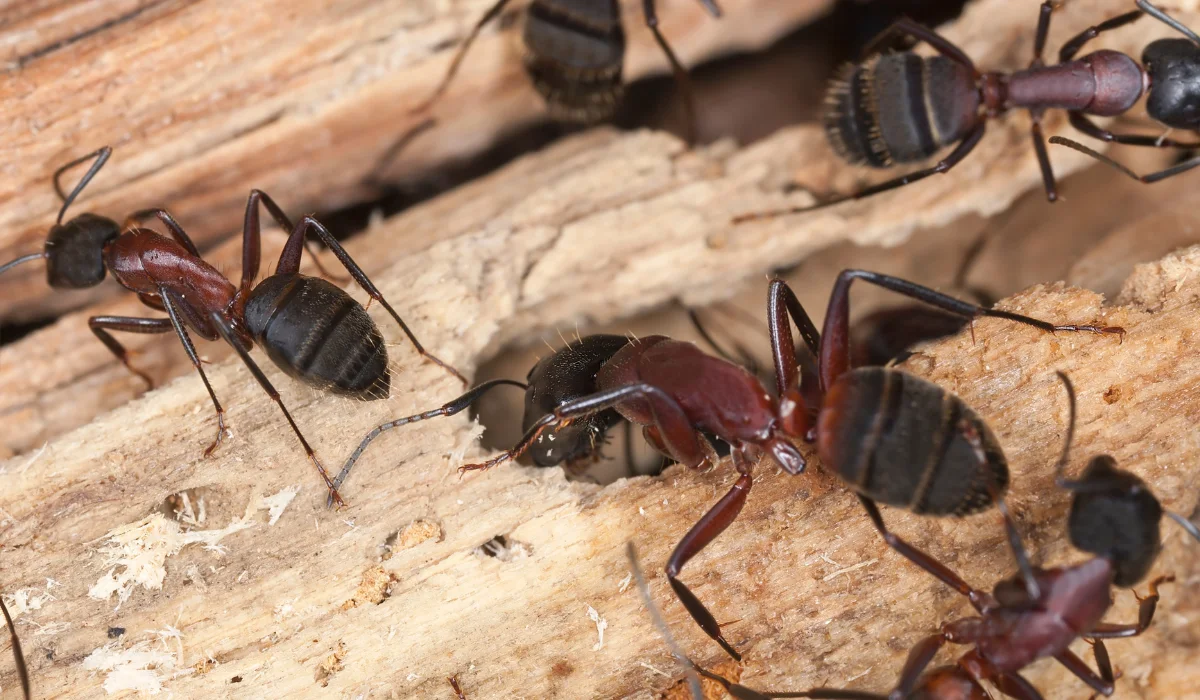
What do you do when carpenter ants invade your home, and you need to keep your pets safe? These ants can cause damage while also posing risks to your furry friends. To get rid of carpenter ants safely when you have pets, use natural repellents like diatomaceous earth or essential oils.
Explore more methods and tips to protect your home and pets from this common pest problem.
Key Takeaways
- Carpenter ants often enter through windows, doors, baseboards, and damp areas.
- Sealing entry points with pet-safe materials like caulk and steel wool keeps ants out.
- While not necessarily guaranteed to be effective, natural ant repellents, such as essential oils, vinegar, or diatomaceous earth, are safe to use around pets.
- Proper food storage and moisture control can help prevent ants, but call a professional if ants remain.
Identify Carpenter Ant Entry Points
Finding where carpenter ants are entering helps prevent their spread. Check areas around windows, doors, baseboards, and plumbing for holes or cracks.
They often prefer moisture-prone locations like kitchens and bathrooms. Look for frass, a sawdust-like material signaling a nest, near these areas.
Block Off Carpenter Ant Pathways Safely
After identifying entry points, block them to stop further access. Use caulk to seal gaps around windows, doors, and any cracks or crevices.
Consider using steel wool or copper mesh for larger holes, which are safe and effective barriers. Applying weatherstripping to doors adds another layer of protection against these ants.
Apply Pet-Safe Natural Repellents
After identifying and blocking entry points, treating areas with pet-safe natural remedies offers another layer of defense.
- Essential Oil Spray: Mix a few drops of peppermint or tea tree oil with water in a spray bottle. Apply along entry points and trails to repel ants naturally. Ensure pets don’t lick treated areas.
- Vinegar Solution: Combine equal parts white vinegar and water to create an ant-killing solution. Spray directly onto entry points and trails for a safe, effective remedy.
- Food-Grade Diatomaceous Earth: Sprinkle a light layer of food-grade diatomaceous earth around entry points. This natural powder dehydrates ants upon contact, eliminating them safely without posing a risk to pets.
Use Pet-Friendly Baits in Targeted Areas
DIY pet-friendly ant baits focus on attracting ants without harming non-target animals. For an effective ant killer, mix a small amount of boric acid with powdered sugar.
Place bait stations in inaccessible areas for pets. It lures worker ants using sugar and kills them with borax.
Track Carpenter Ant Activity Regularly
Tracking ant activity helps you understand their movement and ensure treatment effectiveness. Check ant traps and treated areas regularly for signs of dying ants or new trails.
Witnessing reduced activity suggests the measures are working, while continuous activity might mean more entry points or nests.
Clean Up Trails with Natural Solutions
Ant trails should be erased to prevent ants from following the scent back. Mix water, baking soda, and dish soap to scrub areas where ants travel. This removes pheromones or scent trails and stops new ants from joining their friends.
Another option is spraying areas with water and white vinegar, which has a similar effect.
HOW TO PREVENT FUTURE CARPENTER ANT INFESTATIONS SAFELY
Watch for Signs of Growing Infestations
Regularly inspect your home for indicators of a spreading carpenter ant problem:
- Piles of sawdust (known as frass) around wooden structures, suggesting activities from carpenter ant nests.
- Exoskeletons or dead ants, especially near wooden areas or ant trails.
- Small, smooth holes or noticeable structural damage in wood, which could suggest carpenter ant colony growth.
- Sightings of this ant species in unexpected areas like wall voids, windowsills, or baseboards, often hinting at hidden nests.
- Decaying or moisture-damaged wood, a common nesting spot for carpenter ants.
Remove Sources of Moisture
These types of ants are drawn to moist environments, so controlling moisture levels is key. Fix any leaky pipes and faucets immediately. Check areas under sinks and around stumps or any decaying wood.
Good ventilation is also important, especially in bathrooms and basements. Use a dehumidifier if necessary. This way, you repel carpenter ants and other pests like termites, fleas, and cockroaches.
Store Food Properly
Like sugar ants, carpenter ants are particularly attracted to sweet foods. Poor food storage can attract carpenter ants to your home. Store all pantry items in airtight containers. Keep an eye on pet food—leftovers in pet bowls can also draw ants.
Clean countertops and dining areas regularly to remove crumbs and spills. Maintain cleanliness in your kitchen and dining areas. By reducing these potential food sources, you discourage ants from targeting your home.
WHEN TO SEEK PROFESSIONAL CARPENTER ANT CONTROL
If homemade remedies or traps don’t seem effective after a couple of weeks, it might be time to contact pest control. Persistent sightings of ants around the house, especially near food or moisture sources, can also signal a larger ant problem.
Whether you’re in Baton Rouge or New Orleans, seeking expert help should be easy. For immediate intervention for a severe infestation, let Lajaunie’s carpenter ant exterminators tailor a solution that’s right for your home.
For more information about our services, visit our service page.